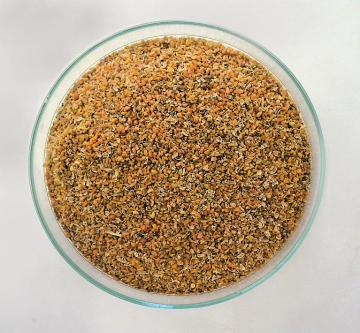
Guar meal (Cyamopsis tetragonoloba)
Common names: Guar, Cluster Bean, Calcutta lucerne, guar bean, gum bean, Siam bean
Local names: Hindi: Gawar, Guwar, Guaar, Goaar Bengali: Jharsim Gujarati: Gavar Kannada: Gorikaayi Konkani: Midkisaang Malayalam: Kothavara Marathi: Bavachi, Citaki, Gavar, Gavari, Govari Mizo: Kaurakasaila, Phali guar, Safaid moth Oriya: Guanrachhuim, Shimba Tamil: Kottavarai Telugu: Goru-chikkudu-kaya
Guar is an erect annual herb 1-2 m high with trifoliate leaves and rose-coloured flowers. It is cultivated as grain, fodder or vegetable and is drought resistant. It is poor for grazing because of its hairy, nettle leaves. It can be cut for fodder as soon as the pods begin to develop. It is palatable to stock if cut and wilted. The seeds are used for extraction of gum (mannogalactan). Guar meal is the by-product of guar gum industry consisting of guar germ material. India is producing around 0.6 million tones guar annually.
Nutritive value
Guar meal contains 75-80% TDN and 50-55% CP. It is a good source of amino acids as it is richer in lysine (2.55%), cysteine (1.16%) and glycine (4.61%) than groundnut cake but comparable in respect of methionine content. It is also rich in trace minerals.
Deleterious factor
Guar meal contains two anti-nutritional factors: anti-trypsin and residual guar gum. Residual guar gum is a polysaccharide (galactomannan) and it may be as high as 18% of the guar meal which is neither digested nor absorbed. Toasting can be followed to inhibit anti-trypsin factor
Inclusion
Guar meal is not palatable to cattle since its inclusion at only 5% level was refused at the initial phase by cows, although if accustomed, cows can accept rations containing as high as 15% raw guar meal. Toasted guar meal, however, has not that acute palatability problem. Further, trypsin inhibitor factor is depressed. Higher level of guar meal may cause diarrhea (watery and sticky faeces), particularly in young calves. It is therefore, always advisable to incorporate guar meal in the ration very gradually and once accustomed may be used as high as 10-15% level in cows and 5-10% level in calves (Banerjee, 2000).
